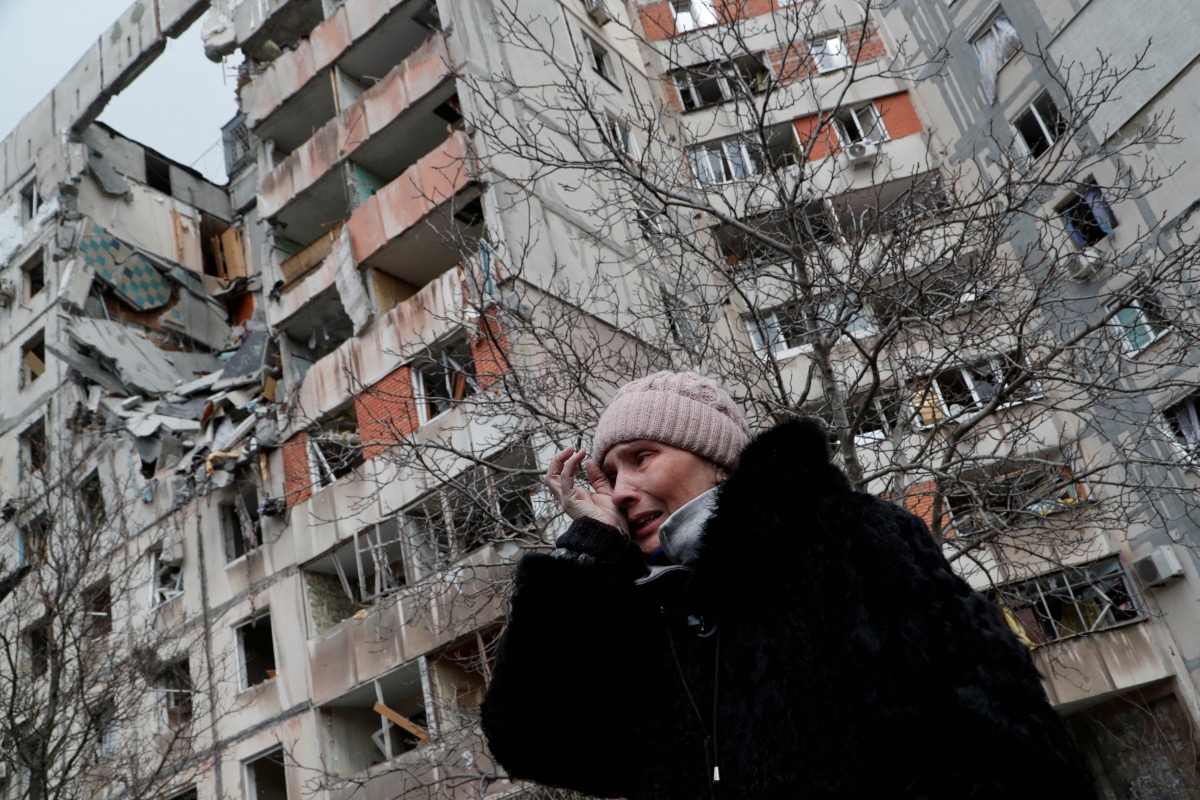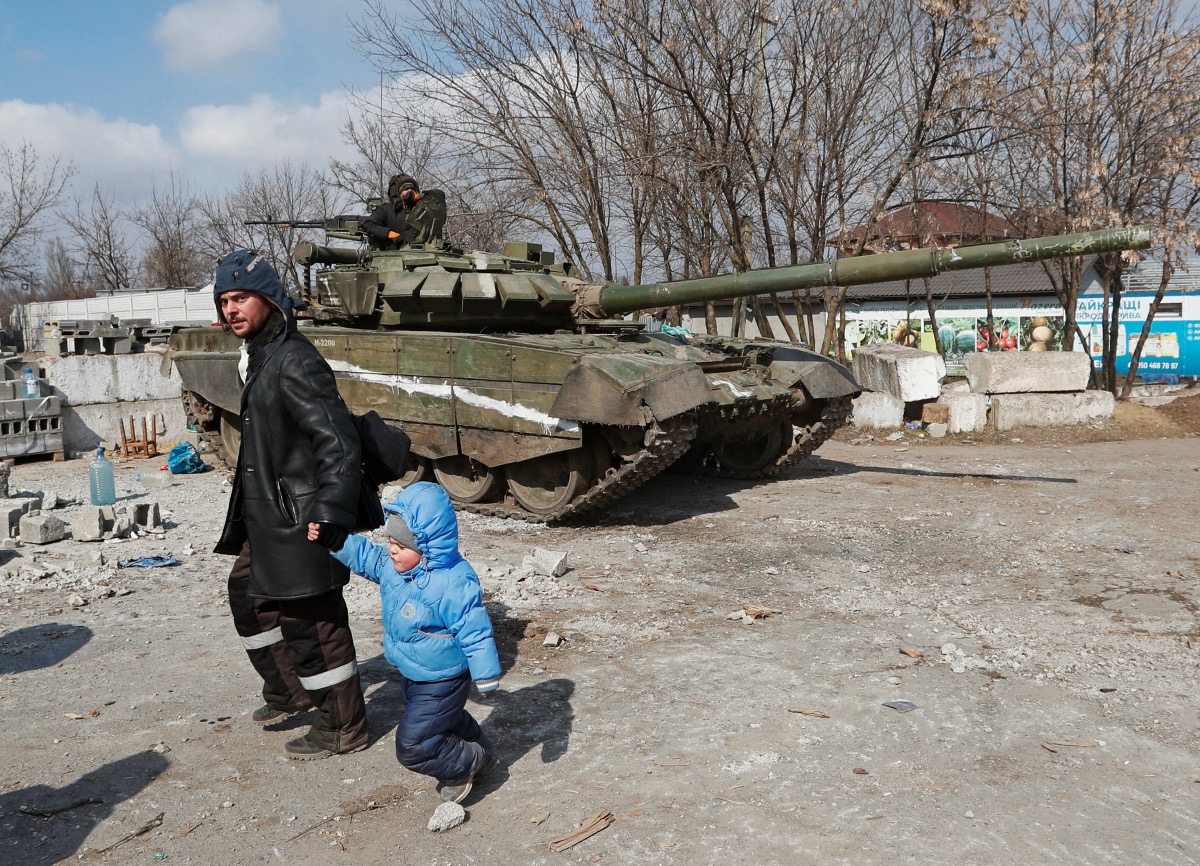Mariupol, Ukraine
Reuters
In Mariupol daily life is a series of harrowing escapes from bomb blasts and basic survival rituals, amid the rubble that lies everywhere.
Uncollected corpses wrapped in blankets, coats or any available covering lie in courtyards cleared of debris. Those killed are often buried in common graves.

A woman reacts while speaking near a block of flats, which was destroyed during Ukraine-Russia conflict in the besieged southern port city of Mariupol, Ukraine on 17th March. PICTURE: Reuters/Alexander Ermochenko.
All around are the blackened shells of the sprawling tower blocks typical of Soviet-era dwellings. Twisted metal on balconies, shattered windows, woods, metal and other wreckage scattered between buildings and in streets.
Some 400,000 people have been trapped in the strategic port city on the Sea of Azov for more than two weeks, sheltering from heavy bombardment that has severed central supplies of electricity, heating and water, according to local authorities.
Russia’s defence ministry said on Friday that its forces were “tightening the noose” around Mariupol and that fighting had reached the city centre.
With no running water or heating, women crouch around make-shift barbecues to cook whatever food they can find. As spring approaches, there is no longer any snow to melt for drinking water.
Residents say no one expected this in post-Soviet Ukraine – an unrelenting onslaught from what was once thought of as a “fraternal” Russia – though some have lived through other upheavals that jolted the country back under Soviet rule.
“She had a Russian passport, Russian citizenship, lots of medals,” said a downcast Alexander, 57, gesturing toward the place in the open where the body of his wife’s mother lies for now.
“My mother-in-law was born in 1936. She survived through the siege of Leningrad,” he said, referring to the 900-day Nazi encirclement of the city now known as St Petersburg. “She was an honoured worker of fish farming in the Russian Federation. So that is where she is.”
Officials in Mariupol say 2,500 people have died since Russian forces poured across the Ukrainian border on 24th February.
We rely on our readers to fund Sight's work - become a financial supporter today!
For more information, head to our Subscriber's page.
Donetsk region Governor Pavlo Kyrylenko said on Friday that around 35,000 had managed to leave the city in recent days, many on foot or in convoys of private cars during the rare moments when Russian shelling subsides.
Those left occasionally verge on despair – the cold and the anxiety taking their toll.
“I feel terrible. I don’t want to blame anyone, but I’m disgusted and scared. And I’m cold,” said one woman, Olga, who wore a pink hat under a hoodie and a big coat. “I just don’t have any words. I wasn’t ready for my life to become like this.”

A local resident walks with a child past a tank of pro-Russian troops during Ukraine-Russia conflict in the besieged southern port city of Mariupol, Ukraine March 18, 2022. REUTERS/Alexander Ermochenko
Russia denies targeting civilians and has accused Kyiv of using them as human shields, something Ukrainian officials deny.
Mariupol is seen as a strategic prize for the Russian invaders to create a bridge between Crimea, annexed by Moscow in 2014, and two separatist enclaves in eastern Ukraine.
A maternity hospital was bombed last week, sending patients fleeing into the street. A theatre used to shelter families forced from their homes was also struck – despite the word “children” being written outside in letters big enough to be read by pilots.
A sense of solidarity among residents fearing for their lives has taken hold. Strangers take in other strangers.
“We spent two days in the basement. She couldn’t move. I thought she wouldn’t survive,” said one middle-aged resident, gesturing to her elderly mother.
“Then we managed to leave the basement. This is the first time I have seen these people. But they sheltered us. And here we are sitting here, covered in blankets. It’s very cold here. We just want to go home.”
Children, look on, uncomprehending.
“Don’t worry, my little darling. Everything will be all right,” said one unsmiling young mother, hugging her two school-age children.
Out in the courtyard, groups of men milled about aimlessly, surveying the shattered buildings.
And around them lay the bodies. The only identifying markers are scraps of paper, appended to makeshift crosses, each bearing a name and a date of birth and death. And no indication when they will be collected.





